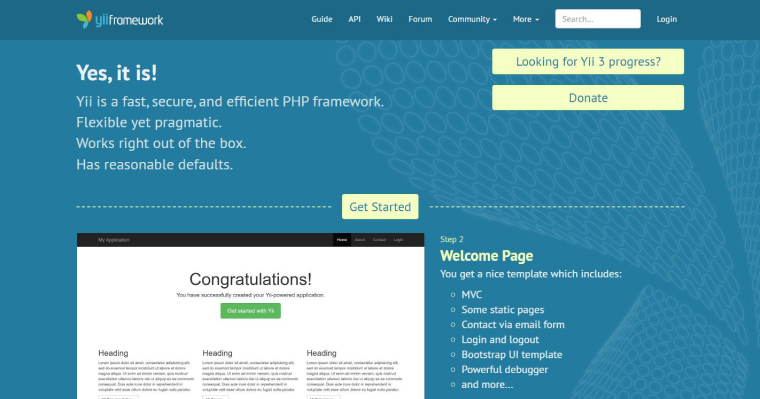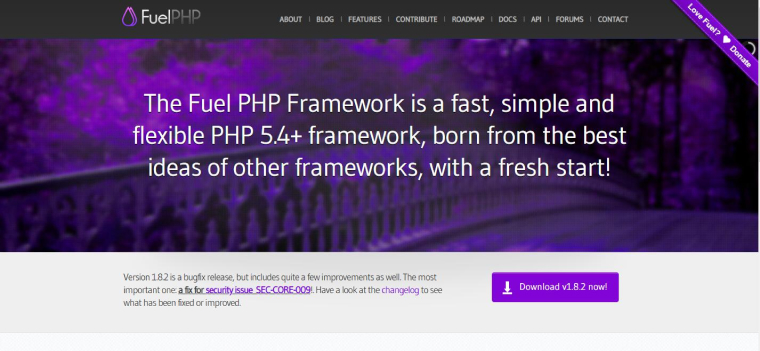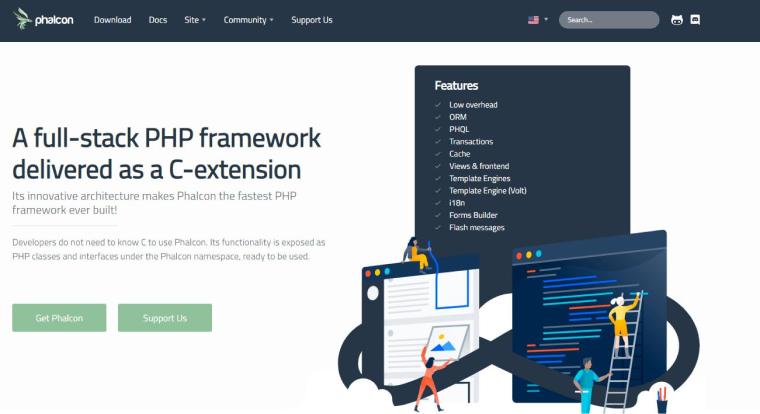10 Best PHP Frameworks for Web Developers
To develop responsive and dynamic ecommerce websites, read and write web files, and keep track of sessions, PHP serves as one of the most widely used server-side scripting programming languages. It could be difficult to write a fully functional PHP code from scratch. Repeating the same steps might get boring after a while.
PHP frameworks facilitate these procedures and enhance efficiency. The web development process may be simplified with the help of these PHP development tools, which give resources such as libraries of pre-made code and elements.
This article will assist you in locating the most popular PHP framework for web development while working with PHP Developers India or worldwide. Here included are the 10 best PHP frameworks for web development, their features and technical details.
1. 10 Best PHP Frameworks

For web development, we have chosen 10 of the top PHP frameworks. Since they are all different, pick the one that best suits your needs. As we can see in the below image from Google trends, Laravel is turning out to be the most popular and easiest PHP frameworks among its counterparts.
Anyone can get these frameworks without cost. To pick the one that works best for you, try a few out.
1.1 Laravel

Laravel is the most widely used PHP framework, and it was released in 2011. It’s capable of quickly and securely processing complex web applications.
Advantages of Laravel:
- Laravel Homestead is a preconfigured Vagrant box that creates a virtual development environment without requiring you to set up a web server or PHP.
- Laravel offers several tools that make it easier to set up and modify complicated applications, including authentication, authorisation, encryption, hashing, account reset, data transfer, routing, and MVC architectural support.
- By automating mundane processes and providing boilerplate code, the Laravel Artisan Console command line tool streamlines the development process.
- Laravel’s speed, security, and expressiveness make it an ideal framework. It’s very adaptable, too, so it can change to accommodate emerging standards in web design.
Disadvantages of Laravel:
- With this framework, a dedicated admin interface is needed for content management and revisions. A content management system (CMS) may be preferable if several users need access to the web application’s configuration settings.
Key Features of Laravel:
- Modules of Laravel functionality
- Pre-programmed features for developing web applications
- Laravel’s Homestead framework
- A vibrant online community of programmers
GitHub Contributions: :Laravel has huge popularity on GitHub with having 73.7k Stars and 23.8k forks.
Stack Overflow Contribution: There are more than 206k Laravel based question-answers available on stack overflow. it makes Laravel one of the most popular web development frameworks.
How to Install Laravel: Primarily there are two ways to install Laravel, both are discussed below:
- Via Laravel Installer: First, download the Laravel installer using Composer.
composer global require "laravel/installer=~1.1" |
2. Via Composer Create-Project: You may also install Laravel by issuing the Composer create-project command in your terminal:
composer create-project laravel/laravel {directory} 4.2 --prefer-dist |
1.2 Symfony

Symfony is a great option for developing scalable web applications. It has a wide variety of capabilities, and its versatile component architecture is adaptable and gives programmers the freedom to choose the features they need.
Advantages of Symfony:
- Symfony is the best PHP framework for creating enterprise-level web apps since it is cross-platform and simple to set up.
- Symfony is adaptable and can work with a wide variety of third-party libraries.
Disadvantages of Symfony:
- Symfony is aimed at more experienced developers and is more challenging to get up and running with than Laravel, which prioritizes ease of use and complexity seldom.
- The security mechanism in Symfony might be challenging to implement.
- Due to its extensive set of features, it can be marginally slower than competing frameworks.
Key Features of Symfony:
- Customized configurations for each module
- In-built Twig template engine with debugging
- Very good documentation
GitHub Contributions: Symfony has 28.4k stars and 9.1k forks on GitHub.
Stack Overflow QAs: It has more than 73k QAs related to the Symfony framework.
How to Install Symfony: You can install Symfony in two ways.
- By Installing Composer which is used to install PHP packages.
- Another way is to install Symfony CLI to run Symfony Locally.
1.3 Yii Framework

Yii means Yes, it is! When it comes to creating cutting-edge online applications, few frameworks can match the efficiency of Yii, a PHP based complete object-oriented framework.
This framework’s flexibility in accommodating many types of web applications is one of its main strengths. It’s a convenient framework for developers who want to create robust, secure web apps without much hassle.
Gii, Yii’s robust class code generator, is yet another distinguishing feature. With this add-on, programmers may construct models and modules and interactively obtain the appropriate code using a web-based coding interface.
Advantages of the Yii:
- It improves the responsiveness and functionality of websites.
- Rather than constantly rewriting SQL queries, developers might instead model the database data as objects.
- The large user base makes it convenient to get assistance when working on a project.
- It’s great for online stores, discussion boards, and more because of its comprehensive security features and easy installation.
- It may be expanded upon, allowing for modifications to nearly all of the core’s code.
Disadvantages of Yii
- Yii has a little high learning curve, which might make getting started a little more challenging for newcomers. As a result, developers need to pay more attention to detail while they work, as even a single typo in the code might have far-reaching consequences.
Key Features of Yii:
- Configuration options
- Participation in a number of add-ons
- Gii code generator
- Pre-installed safety
GitHub Contributions: Yii framework has 4.8k stars and 2.3k forks on GitHub.
Stack Overflow QAs: It has more than 16k QAs related to the Yii framework.
How to Install Yii: You can install Yii in two ways.
- By Installing Composer which is used to install PHP packages.
- Another way is to installing Yii object by writing the below code:
composer create-project --prefer-dist yiisoft/yii2-app-basic basic |
1.4 CodeIgniter

CodeIgniter is a lightweight framework that is only 2MB in size, and that includes all of the documentation. Because of its extensive library of ready-made modules that facilitate the production of robust and reusable components, it is ideally suited to the creation of dynamic websites.
Advantages of CodeIgniter:
- Though CodeIgniter strongly recommends and supports the Model-View-Controller (MVC) design, it is not required.
- CodeIgniter is a compact PHP framework that is much simpler to set up than its competitors.
- CodeIgniter protects against cross-site scripting (XSS) and cross-site request forgery (CSRF) threats, among others.
- This PHP framework can make your web project run faster since it supports numerous caching mechanisms. It’s probable that, in terms of time to completion, this framework is among the best.
- Due to its lower learning curve and extensive documentation, CodeIgniter is one of the most accessible PHP frameworks today.
Disadvantages of CodeIgniter:
- CodeIgniter’s version releases and upgrades aren’t as consistent as some would want, but it’s a great option for novices anyway. Avoid CodeIgniter in favor of a more often maintained framework (for security and other purposes).
Key Features of CodeIgniter:
- Compact framework
- Superb documentation
- The MVC framework is supported
- Integrated safety measures
GitHub Contributions: CodeIgniter has 18.2k stars and 7.7k forks on GitHub.
Stack Overflow QAs: It has more than 69k QAs related to the CodeIgniter framework.
How to Install CodeIgniter:
CodeIgniter is installed in four steps:
- Unzip the package.
- Upload the CodeIgniter folders and files to your server. Normally the index.php file will be at your root.
- Open the application/config/config.php file with a text editor and set your base URL. If you intend to use encryption or sessions, set your encryption key.
- If you intend to use a database, open the application/config/database.php file with a text editor and set your database settings.
1.5 CakePHP

CakePHP is a straightforward and aesthetically pleasing PHP framework. CakePHP makes it simple to create attractive, feature-rich websites and applications.
CakePHP’s CRUD (Create, Read, Update, Delete) operations enables the software to be even more user-friendly for novices. Since its release in the early 2000s, CakePHP has improved in speed and gained a plethora of new features.
Advantages of CakePHP:
- You simply need access to a web server and a copy of the CakePHP framework in order to get started with it.
- Because of its robust security features such as protection against SQL injection, input validation, CSRF, and XSS, it is a popular choice for use in business applications.
- CakePHP comes with extensive documentation, a slew of help forums, and the services of the Cake Development Corporation for premium assistance.
Disadvantages of CakePHP:
- CakePHP’s rigid adherence to norms means it isn’t always the greatest choice for developers who like to deviate from the norm or who need to release often.
Key Features of CakePHP:
- Quicker Development
- Accurate class inheritance
- Validation
- Safety measures
GitHub Contributions: CakePHP has 8.6k stars and 3.5k forks on GitHub.
Stack Overflow QAs: It has more than 31k QAs related to the CakePHP framework.
How to Install CakePHP: You can install CakePHP in two ways.
- By Installing Composer:
mv composer.phar /usr/local/bin/composer |
- By Creating CakePHP project:
composer create-project --prefer-dist cakephp/app:~4.0 my_app_name |
1.6 Laminas Project

Using features like APIs and inheritance, the Laminas Project, the open-source successor of Zend Framework, is an extensible object-oriented programming framework.
It was developed using the Agile technique, which facilitates the delivery of top-notch apps to corporate clients. Laminas Project is easily modified and follows PHP standards, which is useful for PHP experts that need to implement unique features for their projects.
Advantages of Laminas Project:
- When it comes to large-scale, complicated projects, Laminas Project shines.
- Features such as MVC components, a straightforward cloud API, encrypted data storage, and session management are all noteworthy.
- You may pick and choose whatever components you’d want to employ from this framework, and it’s compatible with a wide variety of other PHP libraries. The Laminas Project has a sizable user base and is accompanied by comprehensive documentation.
Disadvantages of Laminas Project:
- Unluckily, the platform is quite difficult to use and may put off newcomers. Making the transition from Laravel to Laminas Project might be difficult.
Key Features of Laminas Project:
- “MVC” Framework
- The incorporation of third-party libraries
- It lets you pick and choose which parts to use.
GitHub Contributions: Laminas project has 1.7k stars and 72 forks on GitHub.
Stack Overflow QAs: It has more than 148 QAs related to the Laminas framework.
1.7 Zend

When it comes to object-oriented frameworks, Zend is one of the most comprehensive options available in the web development realm because of its use of concepts like inheritance and interfaces. It is a great option for creating feature-rich enterprise-level online applications, and it is free and open-source. Zend is quite flexible and uses PHP’s recommended techniques.
Advantages of Zend:
- Zend is a superb solution for developing sophisticated enterprise-level applications due to its well-structured and reusable code.
- It’s compatible with external code snippets and libraries. Software engineers can pick and choose which parts to utilize.
- Zend’s efficiency, safety, and expandability are unparalleled.
- Both Zend’s developer and user communities are substantial and well-documented.
Disadvantages of Zend:
- The learning curve for Zend may be rather high for those creating web applications. Because of the potentially high price of Zend plugins, the framework is not a good fit for low-budget applications.
Key Features of Zend:
- MVC components
- Cloud API
- Encryption
- Session management
GitHub Contributions: Zend has 5.5k stars and 2.6k forks on GitHub.
Stack Overflow QAs: It has more than 20k QAs related to the Zend framework.
How to Install Zend: Zend Framework can be installed in two ways. They are as follows:
- Manual installation: By Downloading it from this link.
- Composer based installation:
$ composer require zendframework/zendframework |
1.8 FuelPHP

The MVC pattern and Hierarchical Model View Controller are two of the framework architecture models that FuelPHP supports. This framework’s HMVC implementation and other essential characteristics make it possible for developers to cut down on time spent on creating complicated applications.
One of the best features of FuelPHP is the way it prioritizes security by screening URIs and encoding the output. As a whole, this architecture has been successfully applied to a wide range of device sizes.
Advantages of the FuelPHP framework:
- Important features include RESTFUL support, URL routing, security against vulnerabilities, and caching.
- It’s simple to set up and use.
- There is a sizable community dedicated to developing and enhancing its packages and add-ons on a regular basis.
- Includes a suite of authentication and authorisation components in its Auth package for further safety.
Disadvantages of FuelPHP Framework
- Due to its relatively young age, FuelPHP may have a more challenging learning curve and provide less assistance than more established frameworks.
Key Features of FuelPHP Framework:
- The utmost support of HMVC
- Measures of extreme security
- A novel technique for redirecting URLs through command-line utilities
- Internal caching mechanism.
1.9 Phalcon

The Full-stack PHP framework Phalcon was initially developed in C and C++. You can use Phalcon without knowing the C programming language because it is essentially a C extension. The lightning-fast speed is the framework’s defining characteristic. This is so because, unlike other accessible frameworks, it just needs a little amount of resources to function. This rapidity may be essential to developers who construct systems with constrained resources. Since 2012, the framework has seen consistent updates, with each new version bringing significant improvements.
Advantages of Phalcon:
- Phalcon allows you to confirm your web applications to enterprise-level standards while maintaining a high degree of customization.
- The framework may be set up quickly and easily.
- Developers are aided in creating safe, highly efficient web apps by means of built-in security measures and caching.
- You’ll also notice that Phalcon uses memory very efficiently, so it works swiftly and effectively.
- Phalcon’s view creation is facilitated by its lightning-fast templating engine, Volt.
Disadvantages of Phalcon:
- Phalcon’s inconsistent updating schedule may be a turnoff for developers that prioritize security.
Key Features of Phalcon:
- C-language based, with high performance and low resource use.
- Modules and libraries can be added selectively.
GitHub Contributions: Phalcon has 1.3k stars and 641 forks on GitHub.
Stack Overflow QAs: It has more than 500 Questions related to the Phalcon framework.
How to Install Phalcon: To install Phalcon you need to type the following commands in your terminal:
sudo apt-get update sudo apt-get install php7.2-phalcon |
1.10 PHPixie

PHPixie, first released in 2012, is an HMVC framework. Its original use was as a fast-loading foundation for static web pages.
Advantages of PHPixie:
Social networking sites, bespoke online apps, and web app development services may all benefit from PHPixie, and getting started with it is a breeze.
PHPixie is made up of many separate parts. That’s why it’s useful even if you don’t have the framework itself. Keep in mind that PHPixie doesn’t have support for components that are developed in isolation from their dependencies, and that it has few modules overall. While PHPixie is still widely used, it is no longer the recommended choice for new development because it hasn’t been continuously updated or supported since 2018.
Disadvantages of PHPixie:
- PHPixie is less well-known and has fewer users because of its young age in the market.
Key Features of PHPixie:
- HMVC architecture
- Standard ORM (object-relational mapping)
- Input validation
- Authorization functionality
- Identification
- Debugging
How to Install PHPixie: First you need to get Composer, after it installs run:
php composer.phar create-project phpixie/project |
2. Why Use a PHP Framework?
In 2023, there are several advantages of using a PHP framework for small projects. The advantages are so great that once you start utilizing a PHP website framework, you are unlikely to wish to go back to not doing so.

2.1 It will Help You Save a Lot of Time
Various factors affect how long it takes to complete a web development project. Saving time by not having to create new code and functions for each project is one of the main benefits of using a PHP framework.
You may save time and avoid having to reinvent the wheel by using pre-existing and reusable PHP components in libraries that are provided as part of frameworks. You may avoid writing code for mundane tasks like form validation by simply importing the necessary components from the PHP framework.
Today, PHP web development frameworks utilize the MVC architecture design, allowing programmers to more easily construct modular code. Model, View, and Controller are the three major components of MVC. Controllers are the functions that access and modify the database; the model is typically the database; the View is the page the user sees (HTML/CSS pages); and the view is what the user interacts with.
The use of a PHP MVC framework allows for the division of labor across developers, speeding up the project as a whole. In addition, the usage of PHP database frameworks simplifies matters considerably.
2.2 It’s Simpler to Work Together
What would it be like to collaborate with a team of web developers if each of them had their own ideas about how to handle a certain part of the project? No work would be done because everyone is too preoccupied with debugging the code.
Teams of programmers may work more effectively together while using a PHP framework, as it keeps everyone on the same page. You’ll not be concerned about disagreements or code moving in the incorrect direction because frameworks and their libraries all adhere to the same set of standards and conventions.
In a nutshell, adopting PHP frameworks allows you to maintain uniformly high standards of code quality. As a result, development teams may make better, more informed judgments about design. Having a solid foundation to build the documentation makes the process much more manageable.
2.3 Assists in Mastering and Implementing Industry-Recommended Coding Standards
Although the term “best coding practices” is very relative, there are several guidelines that can help you save time and effort. The time and effort you save by adopting these habits will add up over time.
Good coding practices, such as organizing your code into clean folders labeled by function, are easy to adopt with the assistance of a PHP framework. As a consequence, your code will be well-structured and easier to take care of.
Another illustration is the naming conventions that many frameworks require you to use. Keeping track of your project’s assets will be less of a hassle if you follow these regulations. It’s a lot easier to locate what you’re searching for when you know the correct terms to use in a search.
2.4 The Risk of being Unsafe Decreases
There is always a security risk online, regardless of where you go or what you do. Similarly, SQL injection attacks and cross site request forgeries or cross site scripting might compromise your PHP code. Of course, you may always protect your own code. But if you follow a plan, the process will be far less daunting.
It’s important to remember that even the most robust PHP framework won’t shield you from every possible security hole; you’ll still need to take extra precautions when developing modern web applications. However, with the help of a solid PHP framework, you can lessen the likelihood of hacker vulnerabilities getting through.
2.5 Project Maintenance is Simplified by Using a Framework
Using a framework makes your projects far less of a maintenance headache. You won’t need to physically write everything or repeat yourself throughout the way, leading to much smaller, easier-to-maintain codebases. Furthermore, the framework’s upkeep is completely taken care of for you at all times.
3. What should You Look for in a PHP Framework?
When deciding on a PHP framework, it’s important to keep many criteria in mind.
The big picture suggests you think about:
Popularity and Community Size: Since many frameworks rely on user contributions, having a vibrant community who are supporting and enhancing the framework is essential.
Philosophy: To what goal does this structure work? If it doesn’t fit in with your project’s requirements, it may be best to search elsewhere.
Sustainability: Will your technology stack continue to support the framework in the future?
Support: If you have any inquiries or worries, who can you talk to? This factor often correlates with the size and prevalence of the community. You can find solutions to any issues you might have by consulting the accessible documentation and internet resources.
However, testing them out before integrating them into your technology stack is the best approach for arriving at a decision. No need to try all of them; instead, pick your top two or three favorites and experiment with them. It’s possible that anything might happen!
4. What is the Best PHP Framework for Beginners?
For those just starting off, it’s best to start with something basic and straightforward. After becoming proficient with them, developers can go on to more robust frameworks.
If you’re looking for a simple PHP framework that you can pick up quickly, look no further than CodeIgniter. Using the Model-View-Controller (MVC) design pattern, this framework makes it simple for PHP newcomers to create functional online applications.
5. Conclusion
When it comes to server-side scripting, PHP is still a strong contender. However, PHP scripting may be time-consuming to create.
PHP frameworks lay the basis for development, freeing developers from mundane yet necessary activities like constantly developing and refactoring code.
Choosing the correct PHP framework for your project might be difficult because there are so many good options.
Remember that all of the PHP frameworks discussed here are open-source and completely free to use. So, you may evaluate a variety of options before settling on the best one for your task.

Hardik Dhanani has a strong technical proficiency and domain expertise which comes by managing multiple development projects of clients from different demographics. Hardik helps clients gain added-advantage over compliance and technological trends. He is one of the core members of the technical analysis team.
PHP is one of the most popular programming languages because it can have a significant effect with very few lines of code. For at least...
 Aug 8, 2023
Aug 8, 2023 



Comments
Leave a message...